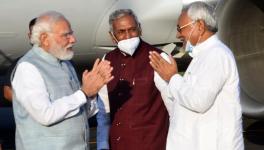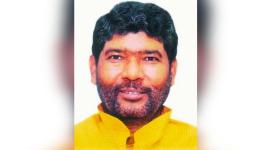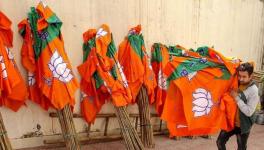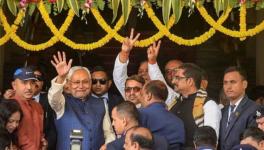Illicit Liquor, Crime and Politics in Bihar Polls
Two phases of polling for the Bihar Assembly election are over; 165 of 243 seats have been spoken for. Yet the mainstream print media has barely addressed the liquor mafia and how it has led to the mushrooming of organised crime in Bihar, even in its rural areas. Many professionally-equipped research bodies also seem to have ignored the liquor-induced crisis, which became a social and political factor in Bihar once the Nitish Kumar government imposed statewide prohibition on 1 April 2016.
With the sole exception of Left forces, a buoyant Opposition has largely maintained silence on the issue. This suggests that regime-change may not tackle the gangsterism that is taking a hold of mofussil Bihar. This is an issue of great concern, going by the experiences of other states. While liquor is consumed everywhere, it is banned only in a few provinces, namely Gujarat, Bihar, Mizoram, Nagaland and Lakshadweep. Liquor bans in the first two states are known to have boosted an alcohol mafia and gambling dens. What is worrying is that these illicit trades are in turn known to form and support what political scientist Ward Berenschot has called the “riot network”.
Berenschot had coined the expression in the context of Gujarat. He derived the term from Paul Brass’ work on communal politics, in which it is posited that communal riots are not sudden or spontaneous occurrences but part of an Institutionalised Riot System, or IRS. When organised crime reaches rural spaces and joins hands with the “riot network”, hoodlums and gangsters become electoral machines. They provide resources, mobilisation and much more to political actors. A complete picture of the menace they pose can be drawn from the instances of communal violence that took place in Bihar in 2018, in which Hindu and Muslim hoodlums—who aspired to become elected representatives—also either played a role in the illegal liquor trade or, at least, some connection with members of liquor mafia.
For instance, one Muslim mukhiya from Paru in Muzaffarpur district, who is currently in jail where on murder charges, is said to have amassed huge profits through his connections with liquor mafia. The killing he is accused of also took place due to rivalry over the illicit liquor trade. He is supposedly patronised by an NDA legislator, who was elected twice and is now contesting the ongoing Assembly election. This leader was accused in the murder of a celebrity at his farm house in Delhi. In 2018, even the Development Officer of the Community Development Block of Paru was suspended, after liquor was found at his official residence. The then Senior Superintendent of Police of Muzaffarpur district is also under suspension, after a huge stash of cash (including Rs.1,000 and Rs.500 currency notes that were declared illegal in November 2016) was recovered from his official residence. Many villages in Muzaffarpur and across rural Bihar have become hooch centres in this way.
The liquor-crime-politics nexus remains woefully under-investigated by government agencies. It is also underplayed in the media. As a result, kingpins go scot free while disadvantaged citizens face the brunt of arrests for alleged violation of prohibition. This has become yet another grievance of the core support bases of the chief minister, the the Ati Pichhda and Mahadalit voters.
Along with local traders, construction contractors and brick-making capitalists, now, the liquor mafia is known to have become a supplier of funds in Bihar’s elections. Panchayat representatives are said to have developed a nexus, which overlaps with the network of existing financiers. Such a network cannot thrive without a complicit local police. Not pulling down this cobweb of connections only suggests that political power-brokers and the media are hand in glove. It can be argued that this network is the financial mainstay of the political classes, and that is why even the Opposition is not speaking out as loudly as it should—again with the exception of the Left.
Before the prohibition was imposed, women had led movements in several parts of Bihar seeking a liquor ban. However, in his earlier tenures (2005 to 2015) Nitish Kumar’s administration spread licensed liquor shops across nooks and crannies of Bihar. The state’s claim at the time was that liquor had raised revenues for the resource-starved state.
It is not just the liquor mafia: political fixers have also spread further across Bihar during the Nitish Kumar era, and many of them have graduated to crime. For an ordinary citizen, the government of Bihar has become an intimidating, inscrutable and inaccessible entity. That is why there emerged a need for fixers.
These fixers have grown in numbers over recent decades because of a series of pro-poor welfare schemes launched by the Manmohan Singh-led UPA-I and UPA-II governments between 2005 and 2013. These schemes touch almost every aspect of the lives of the poor: housing, ration, healthcare, education, road transport, electricity, nutrition, drinking water, banking, driving licenses, passports and visas and so on. The need often arose for people to procure identity cards and get all kinds of other paper-work in order—but in Bihar they confronted an otiose administration. Fixers became more important than ever. The political anthropologist Jeffrey Witsoe has, in his essay on everyday corruption and political mediation in Bihar, characterised fixers as “frontline functionaries of the state”. Such actors, in Bihar and neighbouring West Bengal, are called “mastans”, men and women who transform into stormtroopers of the party in power. Witsoe’s study of Bihar tells the story of how fortunes rise and fall, depending on the caste identity of the fixers, who are seen as linked, by virtue of their identity, with a party in power.
Still most studies on Bihar miss out on how many fixers actually turn into criminal gangsters and how they align with the liquor mafia, land mafia, sand mafia, stone-crushing mafia and develop a nexus with politicians and police.
In Bihar, the liquor mafia and fixers are interrelated, and in many cases their nexuses overlap. Berenschot writes in his book, Riot Politics, that the dependence of citizens on political mediation “underlies the capacity and interests of political actors to instigate and organise communal violence”. Such violence can be an incentive for “various local actors—local criminals, party activists, police officers, etc”. Through these agencies, political actors derive their “capacity to organise and instigate communal rioting”. “The political actors can use their control over the state resources to build up a local base of supporters who are instrumental in spreading rumours and fomenting tensions”, he writes. He also points out that organisations that do not have political support can rarely produce deadly ethnic riots.
A riot network helps perpetuate communal polarisation through “everyday communalism”, which was tried in Uttar Pradesh during 2012-17, and which paid dividends not only in the Lok Sabha election but also helped usher in Yogi raj in the state. In this way, Gujarat and Uttar Pradesh are, in a sense, early examples of what the BJP has planned to do in Bihar. For, communalism would help the BJP overcome caste-based contradictions and also divert attention from concrete issues of employment, economy and development.
The communal tension and violence across Bihar in early months of 2018 (though rising, in fact, since 2013), should be analysed keeping in mind the emergence of “riot networks” which are—and were—being built up through networks of patronage and clientelism. The erosion of Nitish Kumar’s authority over the administrative machinery and the counter-assertion of the BJP as it strives to become a hegemon in Bihar, have to be seen in this context. The BJP has been letting go of some of its long-standing “essential” allies—including the Shiv Sena, the Akali Dal and now, it seems, it is the turn of the JD(U)—as communal polarisation becomes the mainstay of its “politics”.
For instance, consider the communal episodes that took place during February-March 2018 as also the communal clashes that have occurred since 2013. The first spurt took place in 2015, when Nitish Kumar had exited the NDA to align with the RJD and the second when he returned to the NDA fold after leaving the RJD and Congress. For his U-Turns, the Chief Minister has never really been able to really provide concrete or convincing reasons. That is why his moral authority and political capacity eroded and his grip on the administrative machinery weakened.
Insiders in the higher echelons of Bihar’s bureaucracy confess that many senior administrative personnel have started looking up to the BJP to bolster their careers and to curry favours. The poor and marginalised segments lost their sense of participation in Nitish Kumar’s rule, because the bureaucratic set-up came between the people and the state. Even Nitish Kumar’s Janata Darbar—in which people’s problems were taken up by the Chief Minister and the administration through direct interaction—flopped because no credible or sustainable mechanism could come up to follow up on people’s complaints. In many instances, it turned out that the chief minister’s interventions, which were based on people’s complaints, were not even being recorded on the files.
Thus in the ongoing election campaign, Nitish is being targeted not only by political rivals, but also his allies; and even in the eyes of the people he is no longer seen as capable of governing or pursuing development. That is why, regardless of its outcome, this election has played out like a referendum on Nitish. The point is that if the BJP does stage a comeback—now or in a future election—it would like to perpetuate the same mafia-fixer-patronage nexus that it has given impetus to in Gujarat and elsewhere. However, if the Mahagathbandhan comes to power, the Left will have to face the challenge of cracking down on and replacing this network.
Sadly, neither the media and intelligentsia, nor Opposition (except Left parties) are really trying to expose the mafia-fixer menace as strongly as they should, considering its wide ramifications. That is why Biharis, on the eve of this election, are as nervous about the future as they ever were.
The author teaches modern and contemporary Indian history at Aligarh Muslim University. The views are personal.
Get the latest reports & analysis with people's perspective on Protests, movements & deep analytical videos, discussions of the current affairs in your Telegram app. Subscribe to NewsClick's Telegram channel & get Real-Time updates on stories, as they get published on our website.























